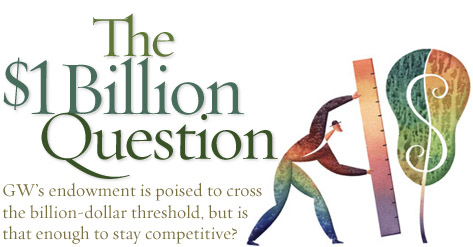
By Matt Lindsay
To many, $1 billion may seem an
outlandish amount of money. But in the realm of
university endowments, that benchmark is becoming
the status quo. At the end of the 2005 fiscal
year, five universities possessed endowments of
more than $10 billion: Harvard University, $25.5
billion; Yale University, $15.2 billion; Stanford
University, $12.2 billion; University of Texas,
$11.6 billion; and Princeton University, $11.2
billion. Harvard and Princeton eclipsed the $1
billion endowment threshold more than two decades
ago.

|
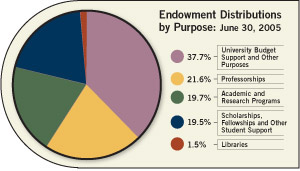
|
As of June 30, GW’s endowment stood at
$962.6 million. The most recent National Association
of College and University Business Officers endowment
survey, released in January, placed GW’s
endowment as the nation’s 69th largest,
between the University of Florida and Syracuse
University. Good company, but not among the endowed
elite. That same survey found 56 schools with
endowments of more than $1 billion, including
several liberal arts colleges with less than 2,000
students, such as Amherst College and Swarthmore
College. Obviously, more money means more opportunities,
but what do these endowment figures mean in practical
terms?
When Stephen Joel Trachtenberg became GW’s
15th president in 1988, the endowment was valued
at about $200 million—its current, nearly
billion-dollar standing reflects increased fundraising
and wise management. At GW’s leadership
retreat in June, Trachtenberg articulated the
importance of the endowment to the University’s
future operations, stating, “If we are going
to prosper academically, we must rely less on
tuition—there is no choice, as I think I’ve
made clear—and more on endowment. Only a
firm financial foundation will allow the University
to remain flexible and first-rate.”
In the last three years, the University’s
endowment experienced tremendous growth, expanding
from about $630 million to nearly $1 billion,
under the leadership of Trachtenberg, Board of
Trustees Chair Charles T. Manatt, Board of Trustees
Investment Committee Chair Russ Ramsey, Executive
Vice President and Treasurer Louis Katz, Vice
President forAdvancement Laurel Price Jones, and
Chief Investment Officer Don Lindsey. Those who
oversee the endowment are now charged with the
task of taking it beyond the billion-dollar benchmark
and keeping it competitive.
Dissecting the Endowment
GW’s endowment is a pool of more than 900
individual endowments, each of which provides
perpetual financial support for a designated purpose.
The endowment sustains professorships, scholarships,
fellowships, research activities, University operations,
and a student investment fund (see following story).
Annual endowment payouts provide universities
with budget support and offset expenses. While
payouts differ, the average university uses about
5 percent of its endowment annually. Thus, hypothetical
“University A” with a $1-billion endowment
will put $50 million in endowment funds toward
its annual operations, while hypothetical “University
B” with a $100-million endowment will have
$5 million annually for its operations—disparity
in endowment size can affect the resources and
services universities offer.
GW does not have a fixed-percentage payout rate;
it uses a complex formula to calculate a payout
rate per unit of the consolidated endowment. The
total payout from GW’s endowment to the
University was more than $36.1 million in 2005.
This payout freed up other funds to support endeavors
including academics and student life.
To Ramsey, BBA ’81, CEO and CIO of Ramsey
Asset Management, “The endowment is your
nest egg; it serves as a safety net for the University.”
Some analysts believe universities are hoarding
money in that nest egg, essentially shortchanging
current students. Ramsey and Lindsey disagree.
“If we spend more than 5 percent, we would
seriously run the risk of eroding and eating into
principal, which means that we’re benefiting
the present constituency at the expense of future
generations,” Lindsey says. “And if
we don’t spend anything, certainly that’s
going to help people down the road, but it means
GW can’t meet its ongoing mission. It’s
a very difficult balance, but one that we constantly
think about and relate back to as we make investment
decisions.”
In basic terms, endowment managers aim to earn
an annual rate of return equal to what a university
spends out of its endowment, plus the ongoing
inflation rate. GW spends about 5 percent annually
and estimates inflation to be 3 percent, thus
the required rate of return is 8 percent.
“If we can make over that 8 percent, then
we’re able to grow the purchasing power
of the endowment, meaning we can provide at least
as much for future generations as we provide today,”
Lindsey says. “But hopefully we will be
able to provide more for future generations than
we can provide today, by continuing to grow above
that long-term expected rate of return. That doesn’t
mean you do it year-in and year-out. Some years
there can be a 20 percent return and some years
there may be a zero percent return. But if you
can try to limit the downside and on average generate
a 10 to 12 percent return, then that’s going
to meet the objective.”
While rate of return goals are consistent across
universities, organizational structure is not.
Universities with smaller endowments often outsource
management. The largest endowments can afford
more employees—Yale has a professional staff
of 20—and several elite universities have
formed wholly owned subsidiaries to manage their
endowments, namely Harvard Management Company.
GW has three professionals, including Lindsey,
dedicated to investment analysis and portfolio
management. The main thrusts of this work are
research—reviewing industry fundamentals,
growth prospects, government regulation, and the
like—and identifying, meeting with, and
selecting money managers. GW employs 35 money
managers to invest the University’s endowment
funds. Although GW’s Investment Office exercises
significant control over the University’s
endowment assets, that responsibility previously
lay elsewhere.
Investment by Committee
It has been a tumultuous decade for the endowment.
Prior to 1996, endowment management, except for
real estate, was outsourced. That year, the Board
of Trustees Investment Committee assumed control,
administering the endowment for the next seven
years, during which its market value expanded
from around $500 million to more than $630 million.
However, growth lagged behind the average achievement
of 41 “peer” universities and seven
“market basket” schools that GW considers
direct competitors: Boston University, Duke University,
New York University, Northwestern University,
Tulane University, University of Pennsylvania,
and Vanderbilt University.
The years between 1996 and 2003 were turbulent
times for university endowments, and the market
as a whole. The bull market of the late 1990s,
where massive gains could be realized, gave way
to the downturn of 2001 and 2002, where positive
returns were rare. As the size of GW’s endowment
fluctuated, it became clear that a dedicated,
full-time staff was needed to recommend allocation
targets, conduct research, interview money managers,
and provide day-to-day oversight of the endowment.
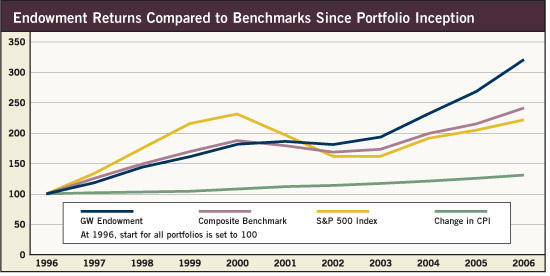
A New Approach
In April 2003, Lindsey joined GW as chief investment
officer, tasked with creating an internal endowment
management operation at the University. Lindsey
brought 16 years of experience, including stints
at the University of Virginia, and as president
and CEO of the University of Toronto Asset Management
Corporation, where he managed the wealthiest Canadian
university endowment.
At GW, Lindsey initially focused on retooling
the endowment’s asset allocation. He recognized
the need to change asset weights and to diversify
into additional asset classes to produce more
stable and predictable returns. This meant reducing
real estate holdings and the reliance on traditional
asset classes, such as U.S. stocks, bonds, and
cash, while expanding into new asset classes such
as private equity, commodities, and hedge funds.
Lindsey says that if assets are correctly balanced,
this diversification strategy can reduce risk.
“I certainly believe in putting fairly
high-risk strategies into the portfolio. But the
important caveat here is you don’t look
at risk in a portfolio on a stand-alone basis.
The real art is combining risky strategies together
so that you can reduce the overall risk because
the strategies are not correlated to each other,
they balance each other,” Lindsey says.
Lindsey also overhauled the University’s
investment process. The new approach mirrors the
target asset allocation, with a renewed focus
on research, due diligence, and investment monitoring.
Lindsey says the new investment process establishes
a unique approach to endowment management.
“We start the process with looking at
major global themes and where we think the growth
opportunities will be over the next five to 10
years. It is really a top-down approach that leads
us to have a view about different areas of the
economy where we see growth opportunities,”
Lindsey explains. “Once we identify those
areas and find a way to invest in that concept,
then we go look for managers to implement that.
We think this is an attractive approach going
forward because, unlike in the ’80s and
’90s where we were in a very strong equity
bull market and all you had to do was own the
S&P 500 Index, today it is much more difficult
to find growth opportunities.”
 Energy,
infrastructure, and international assets are areas
that Lindsey and his team identified as being
underinvested in recent times, but where one can
expect significant global growth in the coming
years. Energy,
infrastructure, and international assets are areas
that Lindsey and his team identified as being
underinvested in recent times, but where one can
expect significant global growth in the coming
years.
Additionally, Lindsey emphasizes the need for
the University to stabilize the annual endowment
payout. In recent years, GW’s spending as
a percentage of endowment has been closer to that
important 5 percent figure, in line with peer
institutions.
Lindsey also promotes the openness of endowment
operations and dialogue with current and potential
donors; as vice president for advancement, Price
Jones appreciates Lindsey’s efforts toward
transparency. “Wise and transparent management
of an endowment leads people to make gifts to
a university,” Price Jones says. “It
is a hindrance if the endowment is not well managed
and if people are in doubt about how it is being
managed.”
The Proof is in the Performance
In the last few years, the endowment management
approach implemented by University leaders has
produced impressive results. The total value of
the endowment has grown by nearly $400 million.
In the three-year period leading up to June 30,
2006, the GW endowment generated a net annual
return of 18.3 percent, significantly outperforming
the composite benchmark three-year net annual
return of 11.6 percent. During the 2006 fiscal
year alone the market value of GW’s endowment
ballooned 17 percent, from $823.1 million to $962.6
million.
Lindsey, Ramsey, and Price Jones see beyond
the tangible monetary benefits associated with
the endowment’s growth to the intangible
advantages, such as positive publicity and more
opportunity to inspire donor confidence. “When
people make the biggest gifts they have ever made,
they view them as investments,” Price Jones
says. “Donors are putting their money to
use at the University, and they want to know they
are investing in a place that will manage their
money well and support those enterprises to which
they gave the money.”
Yet, for all the recent success, there is more
that needs to be accomplished.
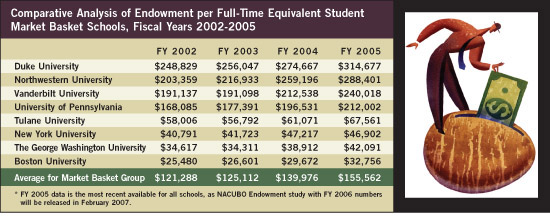
Phil & Jim Bliss/Images.com
Opportunity, Cost
The same NACUBO survey that ranked GW 69th in
the nation in terms of endowment market value
places the University number 228 among private
institutions in terms of endowment assets per
full-time equivalent student. At the end of the
2005 fiscal year, GW’s endowment per FTE
student stood at $42,091, far less than the $1
million-plus sported by Harvard, Princeton, and
Yale. The value of a university’s endowment
per student is reflected throughout an institution,
in diverse areas such as tuition, financial aid,
academic research and programming, and faculty
salaries. Larger endowments per FTE at peer institutions
allow these universities to create unique advantages,
such as waiving tuition for students from low-income
families.
“Endowment per FTE is an important measure
because it determines how much money an institution
is able to allocate per student that attends,”
explains Damon J. Manetta, manager of public affairs
with NACUBO. “Just because an endowment
has a great deal of money behind it does not mean
it has the same buying power.”
GW trails almost all of its market basket competitors
in endowment funds per student. Of the seven universities
previously mentioned—BU, Duke, NYU, Northwestern,
Tulane, UPenn, and Vanderbilt—GW bests only
BU’s endowment per FTE. Schools such as
Duke, Northwestern, Vanderbilt, and UPenn boast
an endowment per FTE that is five times larger
than that of GW. Lindsey estimates that to be
on the same level as its peers, GW would currently
need an endowment valued at $2.5 billion.
Furthermore, GW is not growing at the same rate
as its peers. While the University’s endowment
per FTE student has increased by approximately
50 percent in the past decade, the average endowment
per FTE student growth rate among peer schools
was nearly 150 percent.
“An endowment’s size is important
relative to the number of students it is supporting
and to the amount that a university needs to take
out annually,” Ramsey says. “If you
look at GW versus virtually any of our peers,
our endowment per student is near the bottom.
Alumni need to understand that this endowment
is substantially undersized in terms of needs
of the school.”
Another way to quantify an endowment’s
contribution is to measure the percentage of a
university’s operating budget financed by
endowment funds. In 2005, GW’s endowment
provided $36.1 million toward University operating
expenses, about 6 percent. In comparison, in 2005,
Yale’s endowment provided $565 million to
the university, about one-third of its operating
budget, and Stanford’s endowment contributed
$452 million, approximately 17 percent of its
operating revenue. A more direct competitor, Vanderbilt
University, obtains about 14 percent of its annual
operating budget from the university endowment,
more than double the funding provided by GW’s
endowment.
Although the GW endowment has grown by leaps
and bounds, it still has some ground to make up
to stay in step with peer institutions.
The $1-BillionThreshold and Future Growth
If recent growth trends continue, GW’s
endowment will cross the $1-billion threshold
this academic year. While this is largely a symbolic
milestone, it is significant. After all, it was
only a decade ago that the University’s
endowment crossed the half-billion dollar mark.
In 2004, a 5 percent payout from the endowment
provided the University budget with $34.3 million.
The 5 percent payout budgeted for fiscal year
2007 will provide more than $46.3 million toward
GW operations, $12 million more than just three
years prior.
“The good news is the endowment is at
critical mass. We have a tremendous track record
and a tremendous chief investment officer,”
Ramsey says. “However, we have to watch
carefully the amount of the endowment that goes
into operations and realize that the rate of return
will likely be lower in the future. We can’t
commit ourselves to spending future dollars that
may not be there.”
“Managing an endowment is a delicate balance
between providing financial resources for the
present and for the future,” Lindsey explains.
“That means we have to have in mind not
only preservation of capital so the current constituency,
being the students and the faculty, have resources,
but we also have to think about the fact that
the school has been around since 1821 and it’s
going to be around for another 100 or 200 years
more. It’s hard to think that far in advance,
but we really have to think about the endowment
as being in perpetuity.”
Enhancing the Endowment
Endowment growth in the past decade has been
driven primarily by investment performance. Gifts
accounted for about 14 percent of GW’s endowment
growth between 1995 and 2004, but over the same
time frame, gifts made up roughly 50 percent,
on average, of the endowment growth at BU, Duke,
NYU, Northwestern, Tulane, UPenn, and Vanderbilt.
Investment performance can only do so much—gifts
serve as the catalyst to rapidly vault a university
ahead of its competitors and into the upper echelons.
In each of the past four years, GW has seen
somewhere around $13 to $15 million in annual
gifts to the endowment. Price Jones says she would
like to obtain more endowment gifts for the University,
although oftentimes donors can see a more immediate
impact through other types of giving. Price Jones
says that, in the long term, no other type of
gift is as effective at championing a specific
cause as an endowment, because “an endowed
fund lasts forever.”
“I believe we are rapidly approaching
a world-class investment operation that will help
us grow endowment at the best rate that we can,”
asserts Ramsey. But he agreed with Lindsey and
Price Jones that future endowment growth relies
heavily on both gifts and investment returns:
“The school must dramatically increase the
amount of money that goes into the endowment.”
More than a year ago, Associated Press higher
education writer Justin Pope opined, “The
$10-billion endowment soon may be the new $1-billion
endowment—and $1 billion a mark of mere
mediocrity, not excellence.”
The managers of GW’s endowment are keeping
that prediction in mind as they move forward,
refusing to accept mediocrity and striving for
excellence.
Ramsey
Student Investment Fund Yields Impressive
Returns

|
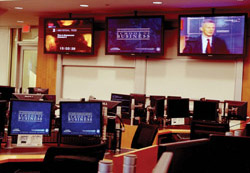
The Ramsey Student Investment Fund
is managed in part in the Capital
Markets Room in the new Ric and Dawn
Duqués Hall.
Julie Woodford
|
One of GW’s most unique gifts came
in 2005, when Russ Ramsey, BBA ’81,
and his wife, Norma, gave $1 million to
the University endowment to establish the
Ramsey Student Investment Fund. This investment
portfolio is managed by GW MBA students
in the Applied Portfolio Management course,
with insights and guidance provided by professors
Don Lindsey, GW’s chief investment
officer, and Ethan McAfee, director of research
at Ramsey Asset Management.
Students are divided into teams that research
stocks in five different sectors. Each student
is assigned two portfolio stocks within
his or her sector to research and analyze.
After this background work, the student
issues a hold or sell recommendation for
each stock. Equities are added to the portfolio
from the pool of companies that students
propose as buy recommendations, based on
additional research in his or her sector.
While each student must issue a hold or
sell recommendation on two companies and
identify two companies as buy recommendations,
the class as a whole votes on how to proceed
on each stock, with majority opinion ruling.
“We are hoping to teach real-world
skills, i.e. investing in the stock market
and doing it successfully,” Ramsey
explains. “The goal is to start a
culture of attracting high-energy and motivated
financial students who want to learn the
capital markets and money management business.”
The class provides a more realistic environment
because the students are dealing with real
money, which brings more pressure to perform.
“The pressure was high because you
feel personally responsible in front of
everyone in the class,” says Mira
Spassova, MBA ’06, a student in the
Applied Portfolio Management course. “It
is embarrassing when you have not done your
homework and researched the company from
A to Z.”
The portfolio management course “keeps
us at the forefront of finance education,”
Lindsey says. “This is a way for us
to put the students in a situation that’s
designed to be as close to an investment
management operation as possible. And certainly
having real money is the element that does
it for us.”
While the overall performance of the student
investment fund is important, of equal significance
is educating students about the structure
and procedures of an investment management
operation.
In the first year of its operation, the
Ramsey Student Investment Fund certainly
did score. Since its inception in May 2005,
the fund produced a 17.1 percent rate of
return, almost five percentage points above
the rate of return of the S&P 500. In
only 14 months, the assets in the fund grew
from $1 million to $1.2 million.
Lindsey believes the course creates a
process that is educational and which can
perform well in practice. In the future,
he hopes students will be exposed to a wider
variety of investment vehicles as the fund
expands into more asset classes; more complex
strategies, including derivatives; and international
markets.
“Even though it takes many years
of practice to develop portfolio management
skills, these students are being introduced
to that practical element in a way where
they feel challenged because there are real
dollars at risk,” Lindsey says. “The
overall objective is to contribute to the
success of business education. We’re
just one component in trying to continue
to move the MBA program forward.”
—Matt Lindsay
|
|